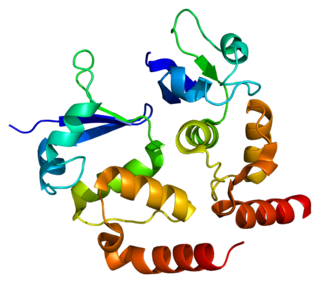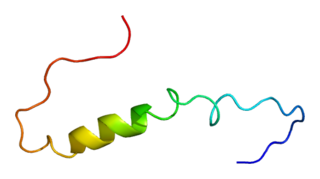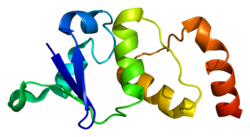
The Kir2.1 inward-rectifier potassium channel is a lipid-gated ion channel encoded by the KCNJ2 gene.

Kv7.3 (KvLQT3) is a potassium channel protein coded for by the gene KCNQ3.

Calsenilin is a protein that in humans is encoded by the KCNIP3 gene.

Gamma-aminobutyric acid receptor subunit rho-1 is a protein that in humans is encoded by the GABRR1 gene.

G protein-activated inward rectifier potassium channel 1(GIRK-1) is encoded in the human by the gene KCNJ3.

Voltage-dependent L-type calcium channel subunit beta-4 is a protein that in humans is encoded by the CACNB4 gene.

Potassium voltage-gated channel subfamily D member 3 also known as Kv4.3 is a protein that in humans is encoded by the KCND3 gene. It contributes to the cardiac transient outward potassium current (Ito1), the main contributing current to the repolarizing phase 1 of the cardiac action potential.

Potassium voltage-gated channel subfamily KQT member 4, also known as voltage-gated potassium channel subunit Kv7.4, is a protein that in humans is encoded by the KCNQ4 gene.

Voltage-gated potassium channel subunit beta-1 is a protein that in humans is encoded by the KCNAB1 gene.

Calcium-activated potassium channel subunit beta-2 is a protein that in humans is encoded by the KCNMB2 gene.

Calcium-activated potassium channel subunit beta-3 is a protein that in humans is encoded by the KCNMB3 gene.

Kv channel-interacting protein 1 also known as KChIP1 is a protein that in humans is encoded by the KCNIP1 gene.

Potassium voltage-gated channel subfamily KQT member 5 is a protein that in humans is encoded by the KCNQ5 gene.

Calcium-activated potassium channel subunit beta-4 is a protein that in humans is encoded by the KCNMB4 gene.

Potassium voltage-gated channel, Shal-related subfamily, member 1 (KCND1), also known as Kv4.1, is a human gene.

Kv channel-interacting protein 4 is a protein that in humans is encoded by the KCNIP4 gene.

Potassium voltage-gated channel subfamily C member 1 is a protein that in humans is encoded by the KCNC1 gene.

Potassium voltage-gated channel subfamily G member 3 is a protein that in humans is encoded by the KCNG3 gene. The protein encoded by this gene is a voltage-gated potassium channel subunit.

Potassium voltage-gated channel subfamily G member 4 is a protein that in humans is encoded by the KCNG4 gene. The protein encoded by this gene is a voltage-gated potassium channel subunit.

Potassium voltage-gated channel subfamily V member 1 is a protein that in humans is encoded by the KCNV1 gene. The protein encoded by this gene is a voltage-gated potassium channel subunit.























